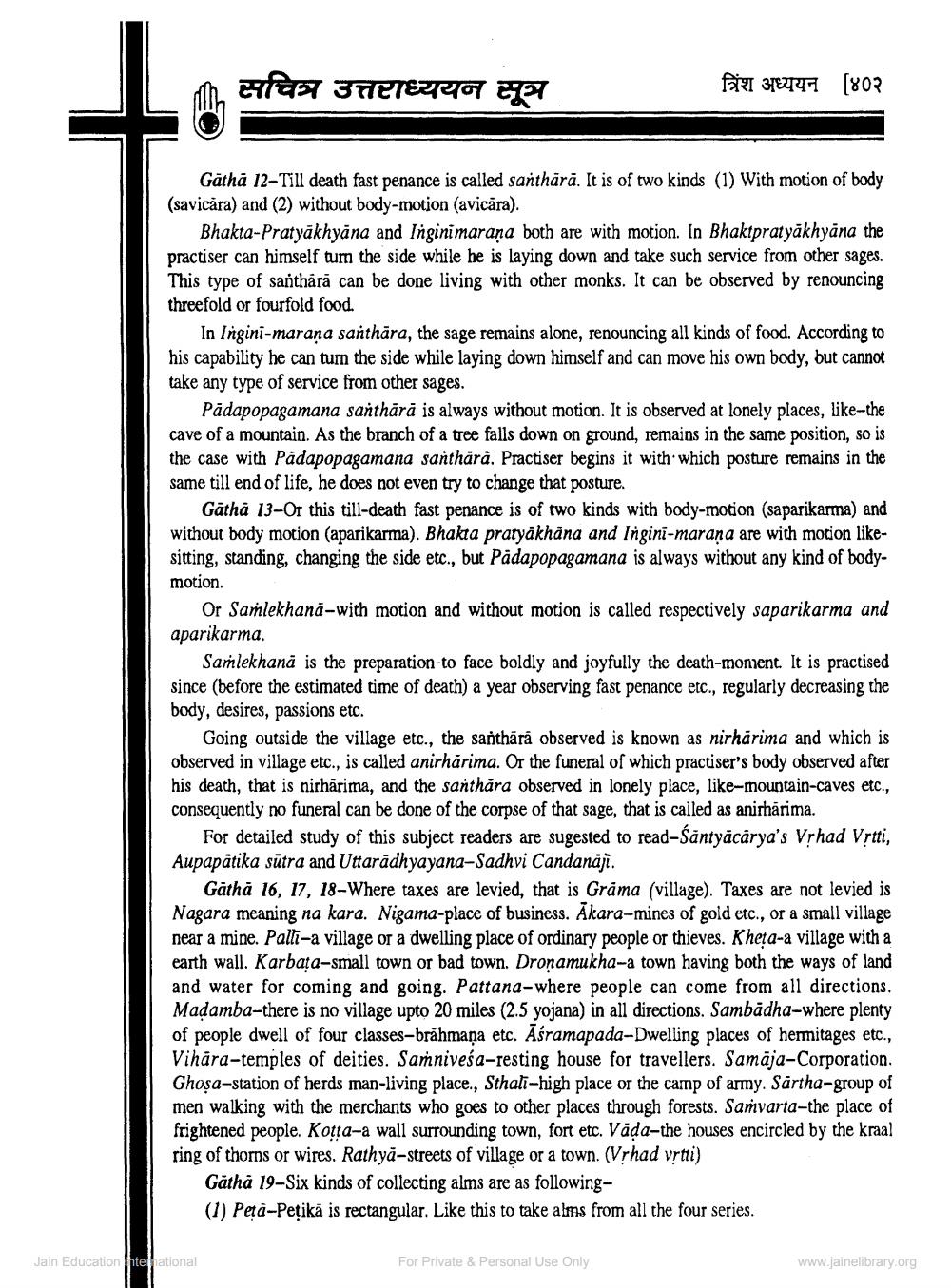________________
त सचित्र उत्तराध्ययन सूत्र
त्रिंश अध्ययन [४०२
Gäthā 12-Till death fast penance is called santhara. It is of two kinds (1) With motion of body (savicăra) and (2) without body-motion (avicāra).
Bhakta-Pratyākhyāna and Ingini marana both are with motion. In Bhaktpratyākhyāna the practiser can himself turn the side while he is laying down and take such service from other sages. This type of santhārā can be done living with other monks. It can be observed by renouncing threefold or fourfold food.
In Ingini-marana santhāra, the sage remains alone, renouncing all kinds of food. According to his capability he can turn the side while laying down himself and can move his own body, but cannot take any type of service from other sages.
Pädapopagamana santhārā is always without motion. It is observed at lonely places, like-the cave of a mountain. As the branch of a tree falls down on ground, remains in the same position, so is the case with Pädapopagamana santhara. Practiser begins it with which posture remains in the same till end of life, he does not even try to change that posture.
Gātha 13-Or this till-death fast penance is of two kinds with body-motion (saparikarma) and without body motion (aparikarma). Bhakta pratyakhana and Ingini-marana are with motion likesitting, standing, changing the side etc., but Pädapopagamana is always without any kind of bodymotion.
Or Samlekhana-with motion and without motion is called respectively saparikarma and aparikarma.
Samlekhana is the preparation to face boldly and joyfully the death-monent. It is practised since (before the estimated time of death) a year observing fast penance etc., regularly decreasing the body, desires, passions etc.
Going outside the village etc., the santhārā observed is known as nirharima and which is observed in village etc., is called anirharima. Or the funeral of which practiser's body observed after his death, that is nirhārima, and the santhara observed in lonely place, like-mountain-caves etc., consequently no funeral can be done of the corpse of that sage, that is called as anirhārima.
For detailed study of this subject readers are sugested to read-Säntyācārya's Vrhad Vịtti, Aupapātika sūtra and Uttarādhyayana-Sadhvi Candanäji.
Gathā 16, 17, 18-Where taxes are levied, that is Grama (village). Taxes are not levied is Nagara meaning na kara. Nigama-place of business. Akara-mines of gold etc., or a small village near a mine. Palli-a village or a dwelling place of ordinary people or thieves. Kheta-a village with a earth wall. Karbața-small town or bad town. Dronamukha-a town having both the ways of land and water for coming and going. Pattana-where people can come from all directions. Madamba-there is no village upto 20 miles (2.5 yojana) in all directions. Sambadha-where plenty of people dwell of four classes-brāhmaṇa etc. Aśramapada-Dwelling places of hermitages etc., Vihara-temples of deities. Samniveśa-resting house for travellers. Samāja-Corporation. Ghosa-station of herds man-living place., Sthali-high place or the camp of army. Sārtha-group of men walking with the merchants who goes to other places through forests. Samvarta-the place of frightened people. Kotta-a wall surrounding town, fort etc. Vada-the houses encircled by the kraal ring of thoms or wires. Rathya-streets of village or a town. (Vrhad vrtti)
Gătha 19-Six kinds of collecting alms are as following(1) Peta-Peţikā is rectangular. Like this to take alms from all the four series.
Jain Education Interational
For Private & Personal Use Only
www.jainelibrary.org




